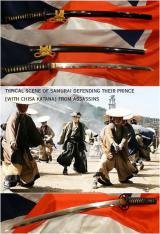Japanese
A Shinto [1596-1781] Iron Tsuba Katana Guard With Brass Mimi
Chisseled with scrolling chanels and a kozuka ana and kogai ana. The oviod tsuba has [south fitted] copper kuchi-beni. The copper plug of the nakago-ana. Their function is to secure the tsuba firmly when mounted on a blade. These plugs are sometimes called sekigane. 2.75 inches across, 3 inches high read more
375.00 GBP
A Japanese Chisa Katana by Master Smith Hoki no kami Fujiwara Hirotaka
This is a delightful sword that would make a superb start to any fine collection of antique weaponry, a future heirloom for generation to come. It has a superb Japanese elegance in its quiet traditional samurai simplicity. Its overall condition and appearance is very fine indeed and would complement any elegant décor or surroundings.
Signed blade under the hilt tsuka, Hoki no kami Fujiwara Hirotaka
A highly rated early Shinto master smith Hoki no Kami Fujiwara Hirotaka was working in 1655 at Echizen province.
He was very skilful swordsmith most highly rated, and was making his swords like this one in the Kanemoto style.
Hirotaka was part of the so-called Echizen Shimohara Ha. Circa 1655, His working date, according to Fujishiro is Meireki period (1655-57) and he rates Hirotaka blades as ‘wazamono’ for their incredible sharpness and Chujosaku. Fujishiro states first he had the title of Hoki (no) Daijo and Hoki (no) Kami as in this example. He continues to state his work is similar to that of Harima Daijo Shigetaka and that these smiths co-operated in gassaku work. The blade is in around 90 to 95% of its original condition Edo polish, and very nice indeed with just a few surface marks. All the fittings are original Edo era, and are decorated with sea shell designs, and an o-sukashi deeply pierced Higo tsuba is Koto period, circa 1500. The chisa katana was able to be used with one or two hands like a katana (with a small gap in between the hands) and especially made for double sword combat a sword in each hand. It was the weapon of preference worn by the personal Samurai guard of a Daimyo Samurai war lord clan chief, as very often the Daimyo would be often likely within his castle than without. The chisa katana sword was far more effective as a defence against any threat to the Daimyo's life by assassins or the so-called Ninja when hand to hand sword combat was within the castle structure, due to the restrictions of their uniform low ceiling height. But in trained hands this sword would have been a formidable weapon in close combat conditions, when the assassins were at their most dangerous. The hilt was usually around ten to eleven inches in length, but could be from eight inches or up to twelve inches depending on the Samurai's preference. Chisa katana, Chiisagatana or literally "short katana", are shoto mounted as katana. It is fair to say wakizashi are shoto which are mounted in a similar way to katana, but in this instance we are considering the predecessors of the daisho. In the transitional period from tachi to katana, katana were called "uchigatana", and shoto were referred to as "koshigatana" and "chiisagatana", in many cases quite longer than the later more normal length wakizashi. A blade of this quality reflects the status of the lord or prince whose life it defended. The saya is in delightful quality high-polish finished traditional lacquer, with just slight age markings from the previous century. The saya is of original age so it displays a very slight element of looseness caused by hundreds of blade withdrawals, made in its lifetime. Overall 35 inches long, blade tsuba to tip 22.25 inches, tsuka 9.5 inches long. read more
Price
on
Request


![A Shinto [1596-1781] Iron Tsuba Katana Guard With Brass Mimi](photos/22652t.jpg)
